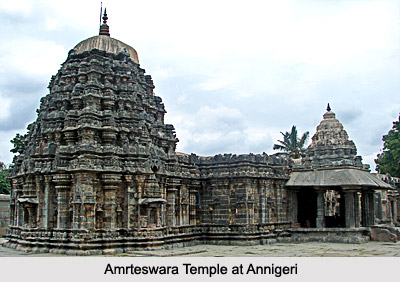 One of the important architectural features of the Western Chalukya Empire was the miniature towers. These towers are supported by pilasters and even by pillars at times. The style in which the miniatures towers were constructed often reflected that of the southern Dravidian and northern bhumija and shekhari. These were widely used in the 12th century.
One of the important architectural features of the Western Chalukya Empire was the miniature towers. These towers are supported by pilasters and even by pillars at times. The style in which the miniatures towers were constructed often reflected that of the southern Dravidian and northern bhumija and shekhari. These were widely used in the 12th century.
The miniature towers that have been constructed on the single pilasters are highly ornamented with sculpted gods and goddesses. The Amrteswara Temple at Annigeri is an instance of this kind of sculpture. The miniature towers from the Western Chalukya Empire comprise intricate sculptures and reflect the influence the style of the north India.
The decorations and ornamentations in the architecture follow a chiseled form. Under the reign of the Western Chalukya kings the form evolved from moulded to a more chiseled form. The evolution of the sharpness, lead the way to the three dimensional structures. The floral decorations were more intricate and thin. Simultaneously the miniature towers on single pilasters were replaced by miniature towers on dual pilasters.
As far as the 11th century miniatures are concerned consist of cornice (kapota), a floor (vyalamala), a balustrade (vedika) and a roof (kuta). These structures are accompanied by magnificent moulding. The 12th century miniatures differed from this style as these do not have pilasters. Instead they are supported by balconies. Under which there are nooks which have been adorned with figure sculptures. The Kalleswara Temple at Hirehadagalli is a glaring instance of this kind of sculpture.



















